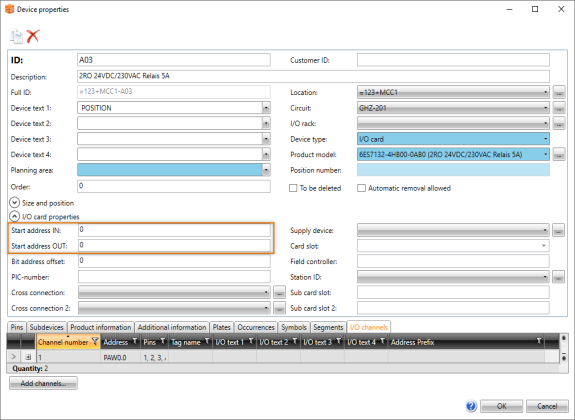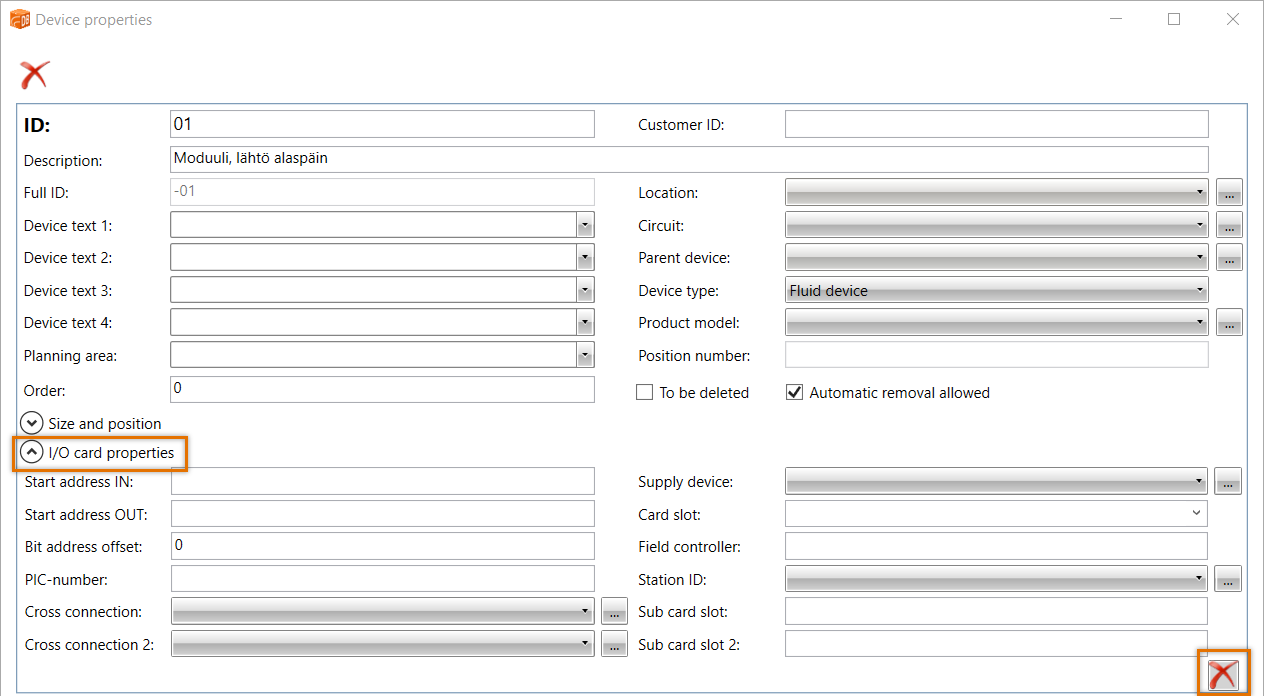Edit properties of individual I/O cards
In the I/O cards grid, you can edit the cells with white background right in the grid.
You can also edit I/O card properties in the Device properties dialog.
Do the following:
-
Select the I/O cards tab.
-
Open the Device properties dialog in one of the following ways:
-
Double-click the first column on the desired I/O card row.
-
Right-click the I/O card row you want to edit, and select Edit device.
The Device properties dialog opens.
-
-
Edit the desired data.
You cannot change the channel addresses, if they have been automatically created. In the I/O card properties section, you can define card manufacturer's addresses to be added automatically by defining either the Start address IN or Start address OUT information. For more information, see Address creation rules.

-
With the
 button, you can copy the I/O card with all its information (except for occurrences) as a new
I/O card.
button, you can copy the I/O card with all its information (except for occurrences) as a new
I/O card. -
With the
 button, you can delete the I/O card.
button, you can delete the I/O card. -
You can cancel editing with the Cancel button, with the cross in the top right corner of the dialog, or with the Esc key.
-
-
Save the changes by clicking OK.
If necessary, you can remove I/O card information from a device in the Device properties dialog with the ![]() button in the I/O card properties section.
button in the I/O card properties section.

The button is shown when the device type is something else than I/O card and the device has I/O card information. It is not possible to remove I/O card information from the I/O card itself. For more information on editing device information, see Edit devices.
Mass edit I/O properties
There are four auxiliary grids on the I/O cards tab on the right: Locations, Stations, Devices and Cross connection mounts. You can easily define I/O card properties as a mass by dragging and dropping information from the auxiliary grids to the main grid.
You can lock the auxiliary grids to the screen from the top right corner with the ![]() button. You can also make your work easier by organizing, grouping and filtering information as you wish.
button. You can also make your work easier by organizing, grouping and filtering information as you wish.
Do the following:
-
Select the I/O cards tab.
-
In the main grid, select one more I/O cards for which you want to define locations, stations, devices or cross connection mounts.
-
From the right side, click Locations, Stations, Devicesor Cross connection mounts to open the respective auxiliary grid.
-
If necessary, organize, group and filter information.
-
Select one or more devices or locations from the auxiliary grid. You can use Ctrl and Shift to select several rows.
-
Drag the selected information to the main grid, on the corresponding column. You can only drop the information to the columns that are highlighted in yellow when you hover on the grid. The selected I/O cards' cells are highlighted in orange in those columns. For example, if you have selected five I/O cards in the main grid and you drag one device from the auxiliary grid and hover on the main grid, the highlights in the main grid before dropping look like this:

-
Drop the information. If you selected several I/O cards, the Connect dialog opens.

-
Confirm connection for the selected information and the selected I/O cards by clicking OK. The added information is now shown in the grid.